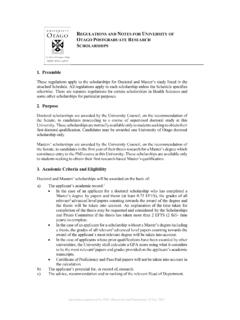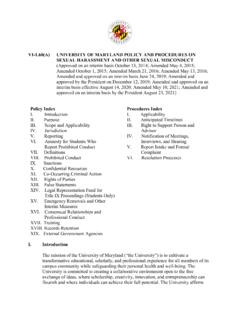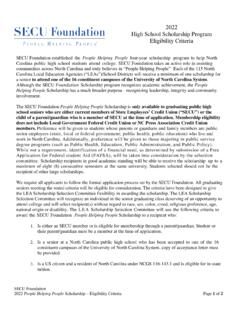Transcription of Boyer’s Model of Scholarship - Faculty Guidebook
1 27 Faculty GuidebookFaculty Development SeriesBoyer s Model of ScholarshipThe appropriate role of the professoriate has been a topic of ongoing debate in higher education. As different types of educational institutions have emerged, the focus of scholarly pursuits and their relative value to the organization have evolved. This module examines how Boyer s Model of Scholarship can be used to clarify and balance roles of college Defi nition of Scholarship Boyer (1997) proposed an expanded defi nition of Scholarship within the professorate based on four functions that underlie the Profi le of a Quality Faculty Member: discovery, integration, application, and teaching.
2 He argues that, within this framework, all forms of Scholarship should be recognized and rewarded, and that this will lead to more personalized and fl exible criteria for gaining tenure. He feels that, too often Faculty members wrestle with confl icting obligations that leave little time to focus on their teaching role. Boyer proposes using creativity contracts that emphasize quality teaching and individualized professional development. He recommends that this Model be based upon the life patterns of individuals and their fi rst element of Boyer s Model , discovery, is the one most closely aligned with traditional research.
3 Discovery contributes not only to the stock of human knowledge but also to the intellectual climate of a college or university. He stresses that new research contributions are critical to the vitality of the academic environment, and that his Model does not diminish the value of discovery Marta Nibert, Educational Consultant for Occupational Therapy The second element, integration, focuses on making connections across disciplines. One interprets one s own research so that it is useful beyond one s own disciplinary boundaries and can be integrated into a larger body of knowledge. He stresses that the rapid pace of societal change within a global economy have elevated the importance of this form of third element, application, focuses on using research fi ndings and innovations to remedy societal problems.
4 Included in this category are service activities that are specifi cally tied to one s fi eld of knowledge and professional activities. Benefi ciaries of these activities include commercial entities, non-profi t organizations, and professional , Boyer considers teaching as a central element of Scholarship . Too often teaching is viewed as a routine function and is often not the focus of professional development. Many professors state that they are primarily interested in teaching, but they feel that their institutions do not value or reward excellence in teaching (Borra, 2001).
5 The academic community continues to emphasize and assign high value to Faculty members involvement in activities other than teaching (Royeen, 1999).Type of ScholarshipPurposeMeasures of PerformanceDiscoveryBuild new knowledge through traditional research. Publishing in peer-reviewed forums Producing and/or performing creative work within established fi eld Creating infrastructure for future studiesIntegrationInterpret the use of knowledge across disciplines. Preparing a comprehensive literature review Writing a textbook for use in multiple disciplines Collaborating with colleagues to design and deliver a core courseApplicationAid society and professions in addressing problems.
6 Serving industry or government as an external consultant Assuming leadership roles in professional organizations Advising student leaders, thereby fostering their professional growth Teaching Study teaching models and practices to achieve optimal learning. Advancing learning theory through classroom research Developing and testing instructional materials Mentoring graduate students Designing and implementing a program level assessment systemTable 1 Boyer Model of Scholarship28 Implementing Boyer s Model In the last decade, many institutions and accrediting organizations have attempted to address concerns of external stakeholders by implementing changes based on Boyer s Model (Changing Expectations of Higher Education and Efforts to Transform Higher Education).
7 Russell Edgerton (DeZure, 2000) classifi ed changes inspired by Boyer s work by compiling data from over 50 colleges, and statistics from the American Association for Higher Education s New Forum on Faculty Roles and Rewards. Edgerton identifi ed three primary areas of activity: setting new expectations for Faculty roles, redesigning the process of evaluating performance, and rethinking the way Faculty are recognized and rewarded. He observed fundamental changes in campus climates, including broad-based discussions about the role of teaching and reinforcement by Faculty rewards systems.
8 Funding agencies, such as the National Science Foundation and the National Endowment for the Arts and Humanities, have begun to follow suit by expanding programs that explicitly improve teacher preparation, curriculum development, and learning , Wilger, and Colbeck (2000) also identifi ed commonalities among departments who maintain a supportive culture for all forms of Scholarship . They conducted more than 300 interviews of Faculty from varied types of institutions (research universities, doctoral-granting institutions, and liberal arts colleges) and from a cross-section of disciplines.
9 Based on their assessment, they identifi ed three main factors that contribute to Faculty isolation and fragmentation: Fragmented communication patterns interfere with the way Faculty communicate with one another about undergraduate education. Tight resources limit opportunities and strain relation-ships. Attempts to create environments that encourage Faculty interaction are undermined by current reward systems. They also identifi ed several following commonalities among departments who maintain a supportive culture for all forms of Scholarship : Faculty interact frequently, fostering a healthy awareness and respect of diverse qualities possessed by colleagues.
10 Decisions are made by consensus: all Faculty members have the opportunity to be involved. There is a sense of generational equity: senior and junior Faculty are viewed as equals. Peer assessment is perceived as a source for growth. They ensure workload equity: all Faculty teach the same number of classes, and an equitable mix of levels, ranging from introductory courses to service courses and advanced seminars. Course rotation systems familiarize all Faculty with the entire curriculum. Faculty value students evaluations and use them periodically to improve curricula and instruction.



